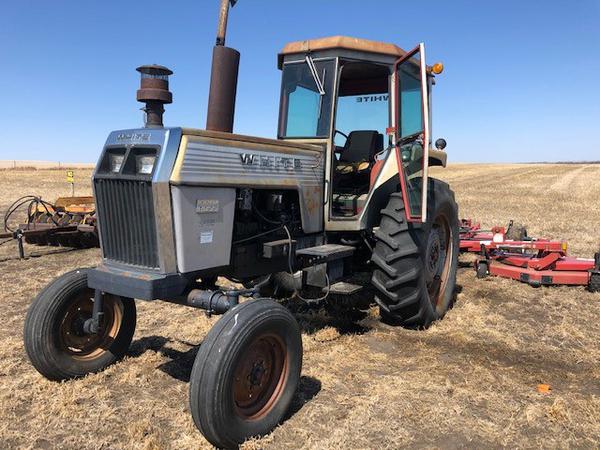Register an account with RME to store your favorite equipment and easily compare between units.
RegisterWinter can be used to a grower’s advantage in preserving grain quality, or it can be an enemy of stored grain, all depending on how carefully it’s managed, according to GSI grain storage specialist Gary Woodruff. | Ron Lyseng photo
You’ve already invested the money to grow, protect and harvest the crop. Don’t let potential dollar returns slip away this winter while your grain’s in storage.
It may seem obvious that there are certain steps you should take to protect the quality and thus the value of your stored grain. However, in the rush to get everything buttoned up before the real winter weather arrives, some things can be overlooked or pushed to the back shelf.
Neglecting simple procedures can end up costing a lot of money when it’s time to ship, says GSI grain conditioning specialist Gary Woodruff. As a reminder, he offers these eight recommendations.
Store grain at a safe moisture level. “There’s a common misperception that grain can be held above 15 percent moisture without risking quality,” said Woodruff. Not true. He recommends that moisture not exceed 15 percent for storage through the following spring, no higher than 14 percent through the following fall and 13 percent for a full year.
Run your aeration fans as grain enters the bin to equalize kernel grain moisture. This typically takes five to 10 days and puts grain in the best shape to store safely. “It’s important to watch the ambient temperature and use aeration fans to get the grain temperature below 10 C as soon as possible. Nearly all insect and mold activity ceases below this temperature.”
Soon after harvest, pull down peaked grain so you have a depression at the top, and the centre is just below the grain at the bin wall. From a side profile, the grain will look somewhat like the letter M, thus promoting air movement in the centre.
“Leave the grain cold only if it will be delivered before June,” Woodruff said. “Make sure you seal the fan entrances and discharge opening to keep high humidity air out. If you are not leaving grain cold or if you’re storing past June, maintain grain temperatures within (12 to 15C) of the outside air to avoid condensation on grain bin interiors.”
Check grain weekly. Climb to the top of the bin, without entering, and observe whether there is a crust or any noticeable smell. An increase in surface moisture usually is the first sign of problems.
Don’t completely empty one bin at a time. When it’s time to ship, take partial amounts from multiple bins to form the letter M and move the remaining grain around within the bin. “That not only promotes air movement but also reduces the risk of grain plugging the discharge.”
Woodruff said that in corn regions, stalk quality might have been compromised by disease and excessive rainfall. “This can lead to downed corn, resulting in mould and dirt that create additional storage issues. In other areas, corn has dried down much more quickly this season due to hot, dry weather. Very dry corn left in the field too long increases grain loss exponentially.”
For out-of-condition grain issues that cannot be remedied by aeration, the only fix is to unload the bin down to where the affected grain can be removed. “This likely means the grain will have to be marketed early and poor grain quality may receive a dock at the elevator.”
More insight, Harvest is complete and your grain is safely stored in the bin, or is it?
Safe winter storage of grain on the farm is a key to successful farm management. Harvested grain may be put into bins at acceptable moisture contents, but is it safe? Knowing what temperature and moisture contents are acceptable for safe storage is critical for safe winter storage of grain. The following information sheds some light on what to watch for in stored grain during winter conditions More stored grain goes out of condition or spoils due to lack of control over grain temperature than any other reason. It cannot be emphasized enough that the control of temperature in a bin of stored grain is absolutely critical. Geographically in Western Canada we are located in a region where we get North America’s most severe temperature fluctuations from one season to the next. The transition between these extremes can happen rapidly or gradually. It is during these transition periods when grain is most at risk due to a phenomena called moisture migration. Moisture migration happens inside the bin when the difference in grain temperature and outside air is the most extreme.
Properly drying and cooling your grain in the fall is key to preserving grain quality through the fall and winter months. If you have harvested your grain in hot, dry conditions, you must be careful to bring the temperature of that grain down to enable safe storage through the winter. Likewise, if due to weather conditions at harvest time you have put your grain in the bin at a higher moisture content than acceptable, you must be careful to lower and maintain the temperature to a point where you can safely store the grain over the winter.
When the bin is initially filled with grain, moisture content and temperature are fairly uniform throughout the bin. However, as outside temperatures begin to drop, continued monitoring of your grain is required. In the winter, as the ambient temperature outside the bin starts to drop, it tends to cool the bin wall which in turn cools the adjacent grain and air inside of the bin. At this point, the cool air creates a current that moves downwards through the grain along the outside perimeter of the grain mass. This air current then moves inward to the center of the bin, here it is warmed by the grain. As the air warms, it starts to move upwards in the center of the bin and picks up moisture from the grain carrying it to the top of the bin where it starts to cool again.
This results in a high moisture zone at the top center of the bin due to a release of moisture as the air cools. In and around this area of high moisture, is where you can expect grain spoilage to occur.
If grain is to be stored in a bin for any length of time, it is important to bring the grain temperature down to a point that will prevent the above mentioned from happening. In order to accomplish this, it is recommended that the grain temperature in the bin be lowered to, or just slightly below, the average ambient temperature that is expected for that time of year. This will prevent the downward movement of colder air. In cooler regions of the country once a uniform grain temperature of approx. -10° Celsius is achieved further cooling is not required. It is important to mention that the producer needs to consult safe storage charts and monitor their bins on a regular basis. Safe storage charts will illustrate what length of time grain can be stored at in relation to moisture levels and temperature.
Aeration (cooling) at this point should be accomplished with .05 to .1 cfm/bu and only until the desired, uniform temperature throughout the bin is achieved. As the season proceeds, the temperature of the grain should be monitored on a regular basis and controlled accordingly by the use of aeration.
By utilizing aeration (whether cooling or warming the temperature of the grain) inside of grain bins, you are able to minimize the effects of moisture migration and maximize the benefits of temperature control within your bin.
The diagrams below depict fall/winter moisture migration; in a bin without aeration and in a bin where aeration is being utilized.
In summary, monitoring moisture and temperature conditions within your bin and having an aeration system in place to help regulate these conditions is key to safe and successful grain storage.
Any more questions? If you are needing some more information or advice, please get in touch with us!
Contact your local RME Branch for more info
RME has a great selection of new and used equipment to fit your needs. Visit RME DealZone
Share This Article:





